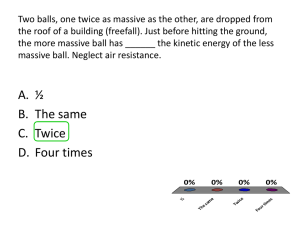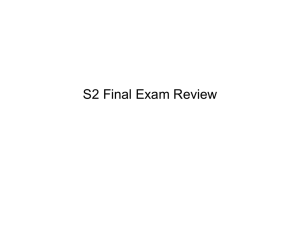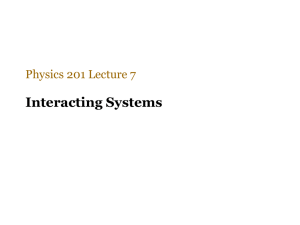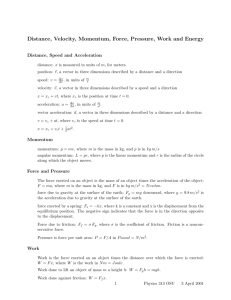Physics 207: Lecture 2 Notes
advertisement
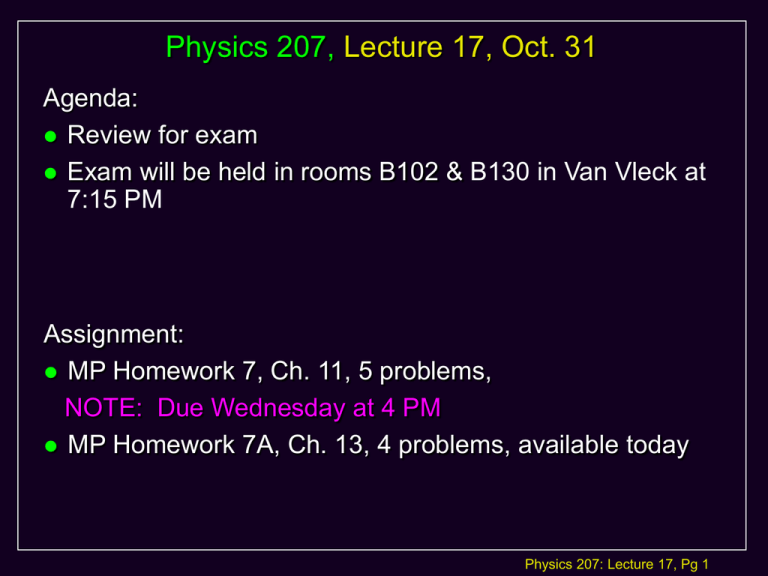
Physics 207, Lecture 17, Oct. 31 Agenda: Review for exam Exam will be held in rooms B102 & B130 in Van Vleck at 7:15 PM Assignment: MP Homework 7, Ch. 11, 5 problems, NOTE: Due Wednesday at 4 PM MP Homework 7A, Ch. 13, 4 problems, available today Physics 207: Lecture 17, Pg 1 Example Gravity, Normal Forces etc. Consider a women on a swing: When is the tension on the rope largest ? And is it : (A) greater than (B) the same as (C) less than the force due to gravity acting on the woman Physics 207: Lecture 17, Pg 2 Gravity, Normal Forces etc. T T v q mg mg Fc = m 02 / r = 0 = T – mg cos q FT = m aT = mg sin q Fc = m ac = m v2 / r = T - mg T = mg + m v2 / r At the bottom of the swings and is it (A) greater than the force due to gravity acting on the woman Physics 207: Lecture 17, Pg 3 Newton’s Laws Three blocks are connected on the table as shown. The table has a coefficient of kinetic friction of 0.350, the masses are m1 = 4.00 kg, m2 = 1.00kg and m3 = 2.00kg. m2 m1 a) b) T1 m3 What is the magnitude and direction of acceleration on the three blocks ? What is the tension in the two cords ? Physics 207: Lecture 17, Pg 4 Problem Three blocks are connected on the table as shown. The table has a coefficient of kinetic friction of mK=0.40, the masses are m1 = 4.0 kg, m2 = 1.0 kg and m3 = 2.0 kg. N m2 T1 T1 m1g m1 T3 m2g m3 m3g (A) FBD (except for friction) (B) So what about friction ? Physics 207: Lecture 17, Pg 5 Problem recast as 1D motion Three blocks are connected on the table as shown. The center table has a coefficient of kinetic friction of mK=0.40, the masses are m1 = 4.0 kg, m2 = 1.0 kg and m3 = 2.0 kg. N m3g m1g T1 T3 m3 m1 m2 ff frictionless frictionless m2g m1g > m3g and m1g > (mkm2g + m3g) and friction opposes motion (starting with v = 0) so ff is to the right and a is to the left (negative) Physics 207: Lecture 17, Pg 6 Problem recast as 1D motion Three blocks are connected on the table as shown. The center table has a coefficient of kinetic friction of mK=0.40, the masses are m1 = 4.0 kg, m2 = 1.0 kg and m3 = 2.0 kg. N m3g m1g T1 T1 T3 T3 m3 m1 m2 ff frictionless frictionless m2g x-dir: 1. S Fx = m2a = mk m2g - T1 + T3 m3a = m3g - T3 m1a = - m1g + T1 Add all three: (m1 + m2 + m3) a = mk m2g+ m3g – m1g Physics 207: Lecture 17, Pg 7 Lecture 17, Exercise Work/Energy for Non-Conservative Forces The air track is once again at an angle of 30° with respect to horizontal. The cart (with mass 1.0 kg) is released 1.0 meter from the bottom and hits the bumper at a speed, v1. This time the vacuum/ air generator breaks half-way through and the air stops. The cart only bounces up half as high as where it started. How much work did friction do on the cart ?(g=10 m/s2) Notice the cart only bounces to a height of 0.25 m A. B. C. D. E. F. 2.5 J 5.0 J 10. J -2.5 J -5.0 J -10. J 30° h = 1 m sin 30° = 0.5 m Physics 207: Lecture 17, Pg 8 Lecture 17, Exercise Work/Energy for Non-Conservative Forces How much work did friction do on the cart ? (g=10 m/s2) W = F Dx = m mg cos q d is not easy to do…esp. if no m Work done (W) is equal to the change in the energy of the system (just U and/or K). Efinal - Einitial and is < 0. (E = U+K) Use W = Ufinal - Uinit = mg ( hf - hi ) = - mg sin 30° 0.5 m W = -2.5 N m = -2.5 J or (D) hi hf 30° (A) 2.5 J (B) 5 J (C) 10 J (D)* –2.5 J (E) –5 J (F) –10 J Physics 207: Lecture 17, Pg 9 Example problem: Going in circles A 2.0 kg disk tied to a 0.50 m string undergoes circular motion on a rough but horizontal table top. The kinetic coefficient of friction is 0.25. If the disk starts out at 5.0 rev/sec how many revolutions does it make before it comes to rest? Work-energy theorem W = F d = 0 – ½ mv2 F = -mmg d = - ½ mv2 d= v2 /(2mg)=(5.0 x 2p x 0.50)2/(0.50 x 10) m = 5 p2 m Rev = d / 2pr = 5p revolutions What if the disk were tilted by 60° ? Physics 207: Lecture 17, Pg 10 Work & Friction You like to drive home fast, slam on your brakes at the start of the driveway, and screech to a stop “laying rubber” all the way. It’s particularly fun when your mother is in the car with you. You practice this trick driving at 20 mph and with some groceries in your car with the same mass as your mother. You find that you only travel half way up the driveway. Thus when your mom joins you in the car, you try it driving twice as fast. How far will you go this time ? A. The same distance. Not so exciting. B. 2 times as far (only ~7/10 of the way up the driveway) C. Twice as far, right to the door. Whoopee! D. Four times as far crashing into the house. (Oops.) Physics 207: Lecture 17, Pg 11 Work & Friction W = F d = - m N d = - m mg d = DK = 0 – ½ mv2 W1= - m mg d1= DK1= 0 – ½ mv12 W2= - m mg d2= DK2= 0 – ½ m(2v1)2 = – 4 (½ mv12) - m mg d2= – 4 (m mg d1) d2= – 4 d1 A. The same distance. Not so exciting. B. 2 times as far (only ~7/10 of the way up the driveway) C. Twice as far, right to the door. Whoopee! D. *Four times as far crashing into the house. (Oops.) Physics 207: Lecture 17, Pg 12 Kinetic Energy To practice your pitching you use two baseballs. The first time you throw a slow curve and clock the speed at 50 mph (~25 m/s). The second time you go with high heat and the radar gun clocks the pitch at 100 mph. What is the ratio of the kinetic energy of the fast ball versus the curve ball ? A. B. C. D. E. ¼ ½ 1 2 4 Physics 207: Lecture 17, Pg 13 Kinetic Energy To practice your pitching you use two baseballs. The first time you throw a slow curve and clock the speed at 50 mph (~25 m/s). The second time you go with high heat and the radar gun clocks the pitch at 100 mph. What is the ratio of the kinetic energy of the fast ball versus the curve ball ? KE2/KE1 = ½ mv22 / ½ mv12 = 1002 / 502 = 4 (A) 1/4 (B) 1/2 (C) 1 (D) 2 (E) * 4 Physics 207: Lecture 17, Pg 14 Work and Energy A block of mass m is connected by a spring to the ceiling. The block is held at a position where the spring is unstretched and then released. When released, the block (a) remains at rest. (b) oscillates about the unstretched position (c) *oscillates about a position that is lower than the unstretched position (d) oscillates about a position that is higher than the unstretched position Physics 207: Lecture 17, Pg 15 Momentum & Impulse A rubber ball collides head on with a clay ball of the same mass. The balls have the same speed, v, before the collision, and stick together after the collision. What is their speed after the collision? A. B. C. D. 0 ½v 2v 4v Physics 207: Lecture 17, Pg 16 Momentum & Impulse A rubber ball collides head on with a clay ball of the same mass. The balls have the same speed, v, before the collision, and stick together after the collision. What is their speed after the collision? (a) *0 (b) ½ v (c) 2 v (d) 4 v Physics 207: Lecture 17, Pg 17 Momentum & Impulse A block sliding along a level frictionless surface collides with an initially stationary target block. The two-block system is isolated. The graphs below represent the individual momenta of the two blocks as a function of time, before and after the collision. One of these graphs represents a physically impossible situation. Which one? (B) Physics 207: Lecture 17, Pg 18 Momentum, Work and Energy A 0.40 kg block is pushed up against a spring (with spring constant 270 N/m ) on a frictionless surface so that the spring is compressed 0.20 m. When the block is released, it slides across the surface and collides with the 0.60 kg bob of a pendulum. The bob is made of clay and the block sticks to it. The length of the pendulum is .80 m. (See the diagram.) To what maximum height above the surface will the ball/block assembly rise after the collision? A. 2.2 cm B. 4.4 cm C. 11. cm D. *22 cm E. 44 cm F. 55 cm Physics 207: Lecture 17, Pg 19 Work and Energy A mass is attached to a Hooke’s law spring on a horizontal surface as shown in the diagram below. When the spring is at its natural length, the block is at position Y. When released from position X, how will the spring potential energy vary as the block moves from X to Y to Z ? (a) It will steadily increase from X to Z. (b) It will steadily decrease from X to Z. (c) It will increase from X to Y and decrease from Y to Z. (d) *It will decrease from X to Y and increase from Y to Z. Physics 207: Lecture 17, Pg 20 Work and Energy An object moves along a line under the influence of a single force. The area under the force vs. position graph represents (a) the impulse delivered to the object (b) *the work done on the object. (c) the change in the velocity of the object. (d) the momentum of the object. Physics 207: Lecture 17, Pg 21 Momentum and Impulse Henri Lamothe holds the world record for the highest shallow dive. He belly-flopped from a platform 12.0 m high into a tank of water just 30.0 cm deep! Assuming that he had a mass of 50.0 kg and that he stopped just as he reached the bottom of the tank, what is the magnitude of the impulse imparted to him while in the tank of water (in units of kg m/s)? (a) 121 (b) 286 (c) 490 (d) 623 (e) *767 Physics 207: Lecture 17, Pg 22 Work and Energy Two particles, one positively charged and one negatively charged, are held apart. Since oppositely charged objects attract one another, the particles will accelerate towards each other when released. Let W+ be the work done on the positive charge by the negative charge. Let W– be the work done on the negative charge by the positive charge. While the charges are moving towards each other, which of the following statements is correct? (a) W+ is positive and W– is negative. (b) W+ is negative and W– is positive. (c) *Both W+ and W– are positive. (d) Both W+ and W– are negative. (e) Without knowing the coordinate system, the sign of the work can not be determined. Physics 207: Lecture 17, Pg 23 Momentum & Impulse Suppose that in the previous problem, the positively charged particle is a proton and the negatively charged particle, an electron. (The mass of a proton is approximately 1,840 times the mass of an electron.) Suppose that they are released from rest simultaneously. If, after a certain time, the change in momentum of the proton is Dp, what is the magnitude of the change in momentum of the electron? (a) Dp / 1840 (b) *Dp (c) 1840 Dp Physics 207: Lecture 17, Pg 24 Work and Energy A block slides along a frictionless surface before colliding with a spring. The block is brought momentarily to rest by the spring after traveling some distance. The four scenarios shown in the diagrams below are labeled with the mass of the block, the initial speed of the block, and the spring constant. Rank the scenarios in order of the distance the block travels, listing the largest distance first. (a) B , A , C = D (b) *B , C , A , D (c) B , C = D , A (d) C = B, A , D (e) C = B = D , A Physics 207: Lecture 17, Pg 25 Newton’s Laws Two boxes are connected to each other as shown. The system is released from rest and the 1.00 kg box falls through a distance of 1.00 m. The surface of the table is frictionless. What is the kinetic energy of box B just before it reaches the floor? (g=9.81 m/s2 ) (a) *2.45 J (b) 4.90 J (c) 9.80 J (d) 9.24 J (e) 9.32 J Physics 207: Lecture 17, Pg 26 Work and Energy If it takes 5.35 J of work to stretch a Hooke’s law spring 12.2 cm from its un-stretched length, how much work is required to stretch an identical spring by 17.2 cm from its un-stretched length? (a) 0.90 J (b) 5.3 J (c) 7.2 J (d) *10.6 J (e) 11.0 J Physics 207: Lecture 17, Pg 27 Work and Energy A person is riding on a circular Ferris wheel. After the wheel has made ¾ of a complete revolution, what is the work done by gravity on the person? (a) positive (b) negative (c) zero (d) *Cannot be determined Physics 207: Lecture 17, Pg 28 Work and Energy An elevator supported by a single cable descends at a constant speed. The only forces acting on the elevator are the tension in the cable and the gravitational force. Which one of the following statements is true? (a) The magnitude of the work done by the tension force is larger than that done by the gravitational force. (b) The magnitude of the work done by the gravitational force is larger than that done by the tension force. (c) The work done by the tension force is zero joules. (d) The work done by the gravitation force is zero joules. (e) *The net work done by the two forces is zero joules. Physics 207: Lecture 17, Pg 29 Work and Forces A 25.0 kg chair is pushed 2.00 m at constant speed along a horizontal surface with a constant force acting at 30.0 degrees below the horizontal. If the friction force between the chair and the surface is 55.4 N, what is the work done by the pushing force? (a) 85 J (b) 98 J (c) *111 J (d) 113 J (e) 128 J Physics 207: Lecture 17, Pg 30 Work and Power A 100 kg elevator is carrying 6 people, each weighing 70 kg. They all want to travel to the top floor, 75 m from the floor they entered at. How much power will the elevator motor supply to lift this in 45 seconds at constant speed? (a) 1.2 · 102 W (b) 7.0 · 102 W (c) 8.7 · 102 W (d) 6.9 · 103 W (e) *8.5 · 103 W Physics 207: Lecture 17, Pg 31 Conservation of Momentum A woman is skating to the right with a speed of 12.0 m/s when she is hit in the stomach by a giant snowball moving to the left. The mass of the snowball is 2.00 kg, its speed is 25.0 m/s and it sticks to the woman's stomach. If the mass of the woman is 60.0 kg, what is her speed after the collision? (a) *10.8 m/s (b) 11.2 m/s (c) 12.4 m/s (d) 12.8 m/s Physics 207: Lecture 17, Pg 32 Conservation of Momentum Sean is carrying 24 bottles of beer when he slips in a large frictionless puddle. He slides forwards with a speed of 2.50 m/s towards a very steep cliff. The only way for Sean to stop before he reaches the edge of the cliff is to throw the bottles forward at 20.0 m/s (relative to the ground). If the mass of each bottle is 500 g, and Sean's mass is 72 kg, what is the minimum number of bottles that he needs to throw? (a) 18 (b) 20 (c) *21 (d) 24 (e) more than 24 Physics 207: Lecture 17, Pg 33 Momentum and Impulse A stunt man jumps from the roof of a tall building, but no injury occurs because the person lands on a large, air-filled bag. Which one of the following statements best describes why no injury occurs? (a) The bag provides the necessary force to stop the person. (b) The bag reduces the impulse to the person. (c) The bag reduces the change in momentum. (d) The bag decreases the amount of time during which the momentum is changing and reduces the average force on the person. (e) *The bag increases the amount of time during which the momentum is changing and reduces the average force on the person. Physics 207: Lecture 17, Pg 34 Newton’s Laws Two sleds are hooked together in tandem. The front sled is twice as massive as the rear sled. The sleds are pulled along a frictionless surface by a force F, applied to the more massive sled. The tension in the rope between the sleds is T. Determine the ratio of the magnitudes of the two forces, T/F. (a) *0.33 (b) 0.50 (c) 0.67 (d) 1.5 (e) 2.0 (f) 3.0 Physics 207: Lecture 17, Pg 35 Momentum and Impulse Two blocks of mass m1 = M and m2 = 2M are both sliding towards you on a frictionless surface. The linear momentum of block 1 is half the linear momentum of block 2. You apply the same constant force to both objects in order to bring them to rest. What is the ratio of the two stopping distances d2/d1? (a) 1/ 2 (b) 1/ 2½ (c) 1 (d) 2½ (e) *2 (f) Cannot be determined without knowing the masses of the objects and their velocities. Physics 207: Lecture 17, Pg 36 Newton’s Laws A factory worker raises a 100. kg crate at a constant rate using a frictionless pulleysystem, as shown in the diagram. The mass of the pulleys and rope are negligible. With what force is the worker pulling down on the rope? (a) 245 N (b) 327 N (c) *490 N (d) 980 N (e) 1960 N Physics 207: Lecture 17, Pg 37 Circular Motion A 2.0 kg miniature car is located 1.0 m from the center of a circular platform that is rotating clockwise at the rate of 1.0 revolution per second. The car itself, as viewed from a STATIONARY observer (NOT on the platform) is moving in a circular path on the platform in a counter-clockwise direction at a speed of 1.0 m/s. (a) What is the magnitude of the centripetal force? (b) What is the tangential velocity with respect to the rotating platform? (a) F = mv2 /r = 2 x 12 / 1 N = 2 N (b) v = 6.28 m/s + 1.0 m/s (CCW) Physics 207: Lecture 17, Pg 38 Work, Energy & Circular Motion A mass, 11 kg, slides down of a frictionless circular path of radius, 5.0 m, as shown in the figure. Initially it moves only vertically and, at the end, only horizontally (1/4 of a circle all told). Gravity, 10 m/s2, acts along the vertical. If the initial velocity is 2 m/s downward then (a) What is the work done by gravity on the mass? (b) What is the final speed of the mass when it reaches the bottom? (c) What is the normal force on the mass when it reaches the bottom Physics 207: Lecture 17, Pg 39 Work, Energy & Circular Motion A mass, 11 kg, slides down of a frictionless circular path of radius, 5.0 m, as shown in the figure. Initially it moves only vertically and, at the end, only horizontally (1/4 of a circle all told). Gravity, 10 m/s2, acts along the vertical. If the initial velocity is 2 m/s downward then (a) What is the work done by gravity on the mass? W = mgR= 11 x 10 x 5 = 550 J (b) What is the final speed of the mass when it reaches the bottom? ½ mvf2 = ½ m vi2 + mgR = 22 J+ 550 J=572 J vf = (1144 / 11) ½ m/s Physics 207: Lecture 17, Pg 40 Work, Energy & Circular Motion A mass, 11 kg, slides down of a frictionless circular path of radius, 5.0 m, as shown in the figure. Initially it moves only vertically and, at the end, only horizontally (1/4 of a circle all told). Gravity, 10 m/s2, acts along the vertical. If the initial velocity is 2 m/s downward then (c) What is the normal force on the mass when it reaches the bottom SFy = m ac = N – mg = m v2 /R N = mg + m v2 /R = (110 + 11 x 1144/11) N = 1254 N = 1300 N Physics 207: Lecture 17, Pg 41 Work and Energy An object is acted upon by only two forces, one conservative and one nonconservative, as it moves from point A to point B. The kinetic energy of the object at points A and B are equal if A. B. C. D. E. the sum of the two forces’ work is zero the work of the nonconservative force is zero the work of the conservative force is zero the work of the conservative force is equal to the work of the nonconservative force None of the above will make them equal Physics 207: Lecture 17, Pg 42 Work and Energy An object is acted upon by only two forces, one conservative and one nonconservative, as it moves from point A to point B. The kinetic energy of the object at points A and B are equal if (a) *the sum of the two forces’ work is zero (b) the work of the nonconservative force is zero (c) the work of the conservative force is zero (d) the work of the conservative force is equal to the work of the nonconservative force (e) None of the above will make them equal Physics 207: Lecture 17, Pg 43 Work and Energy A block is sliding along a frictionless horizontal surface, when it reaches the base of an incline. The block slides up the incline, and then back down again. A frictional force, f, acts on the block while it is on the incline. What is the net work done on the block between when it just starts up the incline and when it returns to the bottom of the incline? (a) mgd - fd (b) mgh - 2fd (c) 2mgh - 2fd (d) 2mgd - 2fd (e) *-2fd (f) zero Physics 207: Lecture 17, Pg 44 Work and Energy A 6.0 kg block is pushed up against an ideal Hooke’s law spring (of spring constant 3750 N/m ) until the spring is compressed a distance x. When it is released, the block travels along a track from one level to a higher level, by moving through an intermediate valley (as shown in the diagram). The track is frictionless until the block reaches the higher level. There is a frictional force stops the block in a distance of 1.2 m. If the coefficient of friction between the block and the surface is 0.60, what is x ? (Let g = 9.81 m/s2 ) (a) 0.11 m (b) *0.24 m (c) 0.39 m (d) 0.48 m (e) 0.56 m Physics 207: Lecture 17, Pg 45 Momentum and Impulse In a table-top shuffleboard game, a heavy moving puck collides with a lighter stationary puck as shown. The incident puck is deflected through an angle of 20° and both pucks are eventually brought to rest by friction with the table. The impulse approximation is valid (i.e.,the time of the collision is short relative to the time of motion so that momentum is conserved). Which of the following statements is correct? A. The collision must be inelastic because the pucks have different masses. B. The collision must be inelastic because there is friction between the pucks and the surface. C. The collision must be elastic because the pucks bounce off each other. D. The collision must be elastic because, in the impulse approximation, momentum is conserved. E. *There is not enough information given to decide whether the collision is elastic or inelastic. Physics 207: Lecture 17, Pg 46 Physics 207, Lecture 17, Oct. 31 Agenda: Review for exam Exam will be held in rooms B102 & B130 in Van Vleck at 7:15 PM Assignment: MP Homework 7, Ch. 11, 5 problems, NOTE: Due Wednesday at 4 PM MP Homework 7A, Ch. 13, 4 problems, available today Physics 207: Lecture 17, Pg 47
